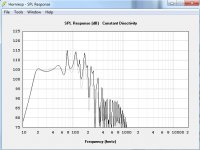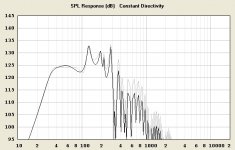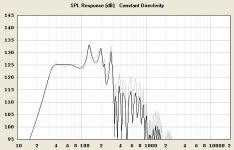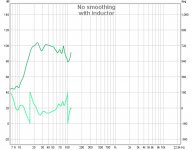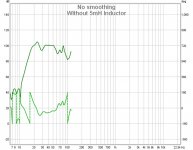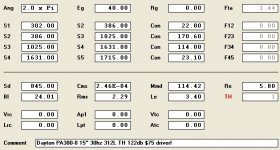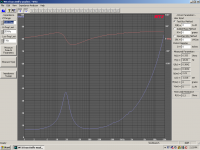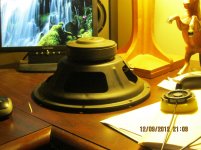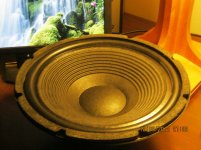hi matthew
if one would ad a coil to the system ,one also need to include the resistance of the coil.
that resistance wil have effect on it aswel
for pa you wil need a verry heavy (expencive ) coil
Yes, It would be A behemoth of gargantuan proportions, a giant wad of copper wire wound around some sort of iron core, expensive but multipurpose because it could also serve as a boat anchor, or a cannon ball
Avoiding the use of such a monstrosity would be the most affordable way to go for sure ... I think my newest revision of the SS-18PS76 doesn't look like it will need a series coil because it is smooth enough to begin with.. I have to wonder though if there are some other designs that require it, Mr Danley uses them for a reason i'm sure ...
Would the DC resistance of the coil take away from the output most significantly at the frequencies where impedance minimums occur? Or would that be an oversimplification? Im also curious about how such a thing would affect the power handling and cone control/damping of the driver?
Same signal level for with and without the coil?Just for funsies, and because I had the data, here's the Lab12 TH that I've fitted with TC sounds drivers, with and without the 5mH coil that's specified.
Just for funsies, and because I had the data, here's the Lab12 TH that I've fitted with TC sounds drivers, with and without the 5mH coil that's specified.
That looks significantly smoother
I have to wonder if the smoother line is what the response will really look like without the inductor ..
Here is a different sort of example where this effect can actually work against you..
This response graph is from a simulation of a reasonably small sized 35hz tapped Horn, straight taper, dialed in for a Dayton PA380-8 15" woofer ..... The design was adjusted using the inductance stated in Dayton's specs list entered into Hornresponse's LE field, the result looked really good being perfectly flat between around 38hz-80hz with a slight dip around 100 and a peak above that, not bad all really ...
Doubling the LE value in this case made the curve look less flat, created gain around 55hz and loss at 65-90hz and also a loss down around 38hz, not nearly as impressive but still useable i suppose.....I'm guessing this cabinet is slightly too small and not quite tuned properly, but i wouldn't have known this if i didn't tinker with the LE value.... I attached the graph for these lackluster results ......
....
Increasing the cabinet size by around 25 liters once again flattened the response with a slight gain over the old cabinet... The newer and slightly larger cabinet looks good with both the initial LE and also the doubled value so i think that its a pretty good indication that I have the cabinet size, ratios and path length pretty well refined ..... A fun exercise ... Its too bad the PA-380 lacks XMAX, it cannot crank out extreme SPLs like some of the other drivers but It might make a good sub for someone who is on a tight budget and wants to have an affordable DIY sub for a small house party or for listening to music in their living room, den or large bedroom ....
The second response graph file is for the larger cabinet...
This response graph is from a simulation of a reasonably small sized 35hz tapped Horn, straight taper, dialed in for a Dayton PA380-8 15" woofer ..... The design was adjusted using the inductance stated in Dayton's specs list entered into Hornresponse's LE field, the result looked really good being perfectly flat between around 38hz-80hz with a slight dip around 100 and a peak above that, not bad all really ...
Doubling the LE value in this case made the curve look less flat, created gain around 55hz and loss at 65-90hz and also a loss down around 38hz, not nearly as impressive but still useable i suppose.....I'm guessing this cabinet is slightly too small and not quite tuned properly, but i wouldn't have known this if i didn't tinker with the LE value.... I attached the graph for these lackluster results ......
....
Increasing the cabinet size by around 25 liters once again flattened the response with a slight gain over the old cabinet... The newer and slightly larger cabinet looks good with both the initial LE and also the doubled value so i think that its a pretty good indication that I have the cabinet size, ratios and path length pretty well refined ..... A fun exercise ... Its too bad the PA-380 lacks XMAX, it cannot crank out extreme SPLs like some of the other drivers but It might make a good sub for someone who is on a tight budget and wants to have an affordable DIY sub for a small house party or for listening to music in their living room, den or large bedroom ....
The second response graph file is for the larger cabinet...
Attachments
Last edited:
Same signal level for with and without the coil?
Yes, the only difference was changing the inductance field.
That looks significantly smoother
I have to wonder if the smoother line is what the response will really look like without the inductor ..
I have a pair of them running now, but using a MiniDSP. If it pleases the court, I can do some measurements later today once the rest of the house is awake, without the MiniDSP, with and without the coil.
I don't fully understand what is going on (big lol on the fully notion). Is the 5mH coil to do some kind of zoeble thing smoothing the impedance of the driver curve?
I'd be curious to know the DC resistance of the coil and the voltage across the coil and driver in a sweep.
I'd be curious to know the DC resistance of the coil and the voltage across the coil and driver in a sweep.
Mat,
can you show the input screens for the 4 examples in post1886
Andrew ,
I dumped the undersized box inputs when i realized that they were flawed and kept the larger box inputs ... The difference was only 25-30 liters ... I think I could recreate the original inputs again if I needed to ...
I am attaching the larger box inputs, which are more properly tuned in my opinion and works well with box 1x LE and 2x LE as opposed to the smaller box which didn't work well with 2x LE in sim (indicating that if i build it i might risk that the real world response even without an added inductor might also be less than ideal) ..
Andrew, the LE value in this set of inputs is the value given by Dayton for the driver, You can raise and lower this value in the sim to see the results .... Epa suggests multiplying the value by 2 to approximate what the real world measurements will actually be like (without an actual series inductor added)...
By the way, the voltage and output in the original example are overly optimistic , instead of 400 watts (56 v) I think a drive level of 200 watts (40v) is safer and more appropriate and still gives you 122db right down to 36hz and -3db at 33hz ... Not bad really for something that would cost you a total of 150 dollars or less to make, including plywood and driver ... It would have enough output for your typical listening room or living room or even a small house party, has enough extension for most any music, and only takes a up a very small footprint in your room if built as a single fold tower style TH .......
I know this P-380 TH not really a single sheet design, So i apologize to JBELL and everyone else for going off topic with this box ..... I will post a sketch of my SS-18PS76 here soon which is a single sheet design..
Attachments
No, just sitting on the counter. I do know that they are Credance drivers but the guy at Credance was really put out that I would even as about a discontinued product and I can find nothing on the net. The number on the frame is 1173593 They are 12" by the way.
Attachments
You've got a monkey coffin driver there.
hehe , so morbid!
Im not sure why but that term makes me giggle.. on the inside ... just a little bit ..
It just means rectangular box right?
I think if he could provide the VAS figure i could use software to figure out the other parameters, but yeah i believe your correct in that it probably wont be a worthwhile TH driver ... The FS is terribly low .... A very loose suspension perhaps?
How much extension do you need Djn? Need to be portable? If you are ok with only getting down to 60hz then a small sealed box will control excursion and allow for some power handling , or even better yet (for more output) if you have a good High-Pass electronic crossover you could set it at 40hz and make a 40hz tuned QWP (some call TL) or even a voight pipe or ML-TL or something along those lines ...
- Home
- Loudspeakers
- Subwoofers
- Single sheet TH challenge
